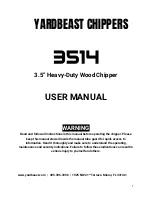
JOHNSON CONTROLS
93
FORM 150.27-NM1
ISSUE DATE: 09/30/2015
6
GENERAL
Commissioning of this unit should only
be carried out by Johnson Controls Au-
thorized personnel.
Commissioning personnel should be thoroughly famil-
iar with the information contained in this literature, in
addition to this section.
Perform the commissioning using the detailed checks
outlined in the
Equipment Pre Start-Up And Start-Up
as the commissioning proce-
dure is carried out.
PREPARATION – POWER OFF
The following basic checks should be made with the
customer power to the Unit switched OFF.
Inspection
Inspect unit for installation damage. If found, take ac-
tion and/or repair as appropriate.
Refrigerant Charge
Units are normally shipped with a nitrogen hold-
ing charge. Check that refrigerant pressure is present
in both systems and that no leaks are apparent. If no
pressure is present, a leak test must be undertaken, the
leak(s) located and repaired. Remote systems and units
are supplied with a nitrogen holding charge. These sys-
tems must be evacuated with a suitable vacuum pump/
recovery unit as appropriate to below 500 microns.
Do not liquid charge with static water in the cooler.
Care must also be taken to liquid charge slowly to
avoid excessive thermal stress at the charging point.
Once the vacuum is broken, charge into the condenser
coils with the full operating charge as given in
Service and Oil Line Valves
Open each compressor suction, economizer, and dis-
charge service valve. If valves are of the back-seat
type, open them fully (counterclockwise) then close
one turn of the stem to ensure operating pressure is fed
to pressure transducers. Open the liquid line service
valve and oil return line ball valve fully in each system.
Compressor Oil
To add oil to a circuit – connect a YORK hand oil pump
(Part No. 470-10654-000) to the 1/4" oil charging con-
nection on the compressors with a length of clean hose
or copper line, but do not tighten the flare nut. Using
clean oil of the correct type (“V” oil), pump oil until
all air has been purged from the hose then tighten the
nut. Stroke the oil pump to add oil to the oil system.
Approximately 1.8-2.3 gallons is present in the each
refrigerant system.
Additional oil change may be required
depending upon the length of piping.
Oil levels in the oil equalizing line sight glass should
be between the bottom and the middle of the sight glass
with the system off. High oil levels may cause exces-
sive oil carryover in the system. High oil concentration
in the system may cause nuisance trips resulting from
incorrect readings on the level sensor and temperature
sensors. Temperature sensor errors may result in poor
liquid control and resultant liquid overfeed and sub-
sequent damage to the compressor. While running, a
visible sign of oil splashing in the sight glass is normal.
Isolation / Protection
Verify all sources of electrical supply to the unit are
taken from a single point of isolation. Check that the
maximum recommended fuse sizes given in
Control Panel
Check the panel to see that it is free of foreign materi-
als (wire, metal chips, etc.) and clean out if required.
Power Connections
Check that the customer power cables are connected
correctly to the terminal blocks or optional circuit
breaker. Ensure that connections of power cables with-
in the panels to the circuit breaker or terminal blocks
are tight.
SECTION 6 – COMMISSIONING
















































